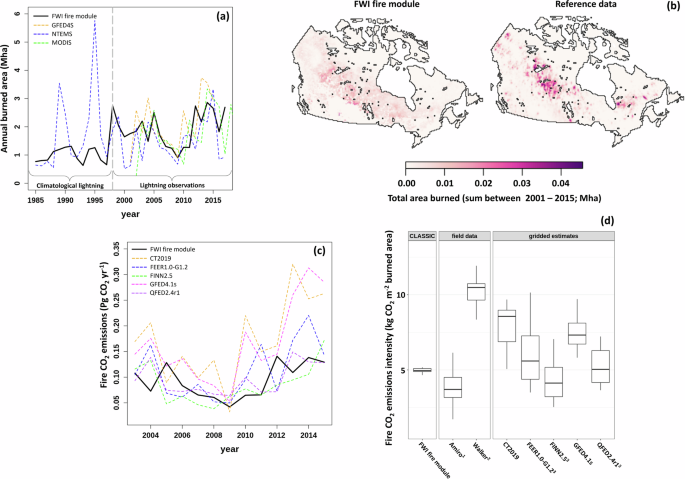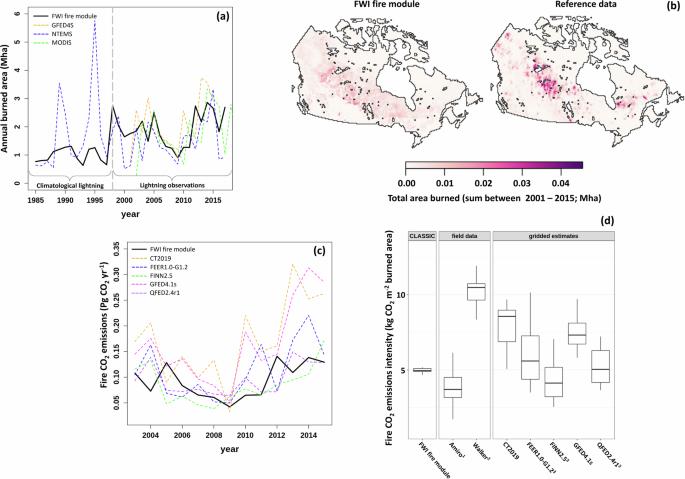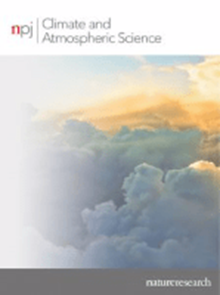Global climate change below 2 °C avoids large end century increases in burned area in Canada
IF 8.5
1区 地球科学
Q1 METEOROLOGY & ATMOSPHERIC SCIENCES
引用次数: 0
Abstract
Wildfire impacts the global carbon cycle, property, harvestable timber, and public health. Canada saw a record fire season in 2023 with 14.9 Mha burned—over seven times the 1986–2022 average of 2.1 Mha. Here we utilize a new process-based wildfire module that explicitly represents fire weather, fuel type and availability, ignition sources, fire suppression, and vegetation’s climate response to project the future of wildfire in Canada. Under rapid climate change (shared socioeconomic pathway [SSP] 370 & 585) simulated annual burned area in the 2090 s reaches 10.2 ± 2.1 to 11.7 ± 2.4 Mha, approaching the 2023 fire season total. However, climate change below a 2 °C global target (SSP126), keeps the 2090 s area burned near modern (2004–2014) norms. The simulated area burned and carbon emissions are most sensitive to climate drivers and lightning but future lightning activity is a key uncertainty.


全球气候变化低于 2 °C 可避免加拿大烧毁面积在本世纪末大幅增加
野火影响全球碳循环、财产、可采伐木材和公众健康。加拿大在 2023 年迎来了创纪录的火灾季,烧毁面积达 1490 万公顷,是 1986-2022 年平均烧毁面积 210 万公顷的七倍。在此,我们利用基于过程的新野火模块,明确表示火灾天气、燃料类型和可用性、火源、灭火和植被的气候响应,以预测加拿大未来的野火情况。在快速气候变化(共享社会经济路径[SSP] 370 & 585)的情况下,2090 年代的模拟年燃烧面积达到 10.2 ± 2.1 到 11.7 ± 2.4 兆公顷,接近 2023 年火灾季节的总面积。然而,低于 2 ° C 全球目标(SSP126)的气候变化使 2090 年的燃烧面积接近现代(2004-2014 年)标准。模拟燃烧面积和碳排放量对气候驱动因素和闪电最为敏感,但未来闪电活动是一个关键的不确定因素。
本文章由计算机程序翻译,如有差异,请以英文原文为准。
求助全文
约1分钟内获得全文
求助全文
来源期刊

npj Climate and Atmospheric Science
Earth and Planetary Sciences-Atmospheric Science
CiteScore
8.80
自引率
3.30%
发文量
87
审稿时长
21 weeks
期刊介绍:
npj Climate and Atmospheric Science is an open-access journal encompassing the relevant physical, chemical, and biological aspects of atmospheric and climate science. The journal places particular emphasis on regional studies that unveil new insights into specific localities, including examinations of local atmospheric composition, such as aerosols.
The range of topics covered by the journal includes climate dynamics, climate variability, weather and climate prediction, climate change, ocean dynamics, weather extremes, air pollution, atmospheric chemistry (including aerosols), the hydrological cycle, and atmosphere–ocean and atmosphere–land interactions. The journal welcomes studies employing a diverse array of methods, including numerical and statistical modeling, the development and application of in situ observational techniques, remote sensing, and the development or evaluation of new reanalyses.
 求助内容:
求助内容: 应助结果提醒方式:
应助结果提醒方式:


